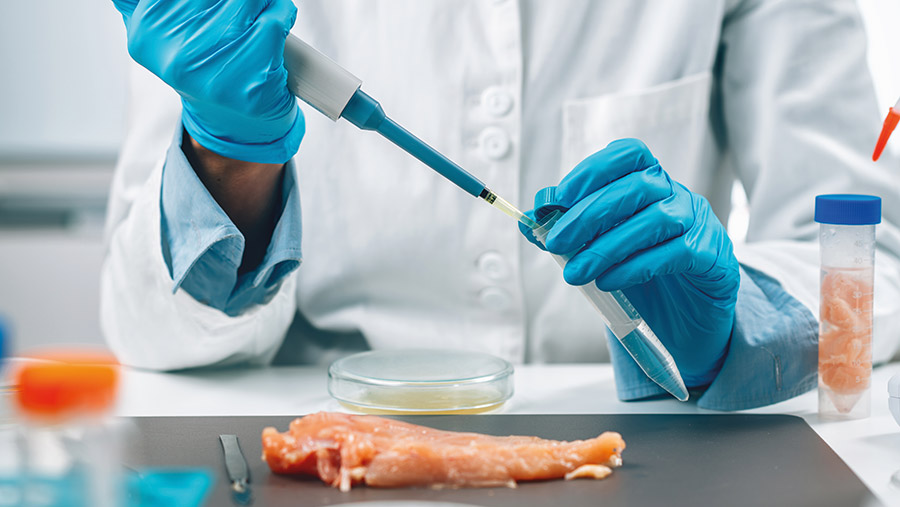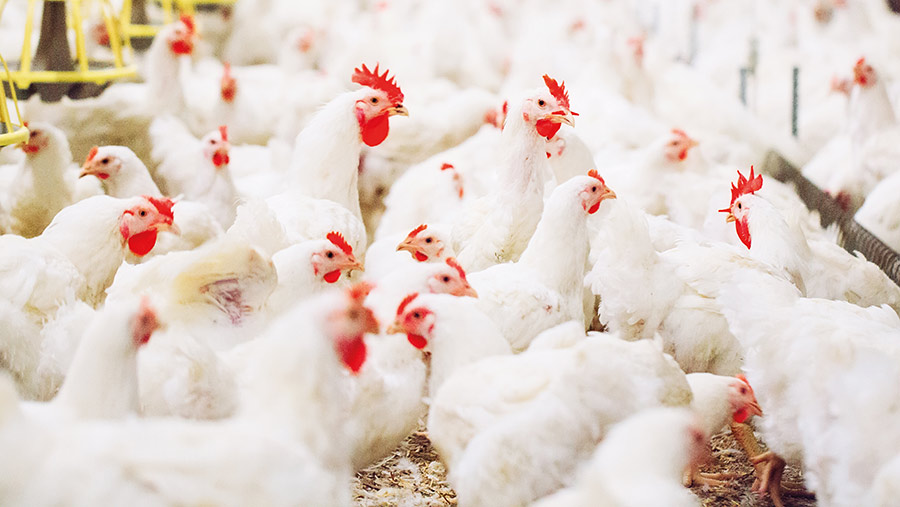Salmonella strains poultry farms need to be aware of, and why
 © Microgen/Adobe Stock
© Microgen/Adobe Stock Salmonella has generally become less prevalent in broilers over the past few years, although there are localised pockets in the South West of England.
“We have found exotic types, like Salmonella montevideo, in poultry houses and these are historically associated with high-oil raw feed material,” says poultry vet Ben Crisp of St David’s vet practice.
“But reportable salmonella has seen a decline due to the National Control Programme [NCP].”
See also: How a leading pullet rearer keeps birds salmonella-free
The NCP is an initiative aimed at reducing and controlling the prevalence of salmonella in broilers across the EU, to a target agreed by all member states and the EU Commission. It has remained in place in the UK since Brexit.
Reportable strains include Salmonella enteritidis and Salmonella typhimurium. “These are the strains that cause the vast majority of illness in the human population,” says Mr Crisp.
“They are currently at a historical low in the human population. Since Covid-19, fewer people have been eating out and travelling abroad, which is what these strains tend to be associated with.”
Strains on the watchlist
There are other strains on the watchlist, however. Salmonella infantis, virchow and hadar are monitored, particularly further up the broiler breeding chain.
Figures from the Animal and Plant Health Agency (Apha) for 2021 show that, of 5,600 confirmed human salmonella cases, 12% were associated with infantis.
Mr Crisp says: “It is normally 3%, but 170 plus cases were associated with pork scratchings from one factory. Apha believes the rest were associated with poultry products.”
Also in 2021, sampling of poultry units selling eggs and meat under the NCP showed 1,600 positive tests for salmonella. Of these, infantis accounted for 2.5%.
“It is not a lot, but it is there,” he says. “It can be very resistant to disinfectants and can live in the soil for years. It can also live in chicken fluff. Once it’s on a farm, hatchery or mill, it’s a long battle to conquer it.”
There’s also a cost. “It’s expensive, with sheds taking more time to clean out and longer turnaround times, requiring more labour and downtime.”
In terms of salmonella strains that are lethal to chickens, but don’t affect humans, Salmonella gallinarum and Salmonella pullorum are of greatest concern. However, these are not currently present in the UK commercial flock.
Apha assesses most chicken feed raw materials, particularly those high in oils such as soya, rapeseed and linseed, which are most likely to contain salmonella.
“Processing them reduces cross-contamination and levels of salmonella in finished feed, which is mostly pelleted by applying heat, which massively reduces salmonella levels,” says Mr Crisp.
“But it is impossible to get to zero. A lot can live in the environment in faeces and feather dust.”
Prevention measures
Preventing salmonella means avoiding transmission between flocks. It involves good biosecurity including changing boots, wearing gloves and changing overalls between sheds.
Wheelbarrows and buckets should stay in a particular shed, says Mr Crisp. “This means if you get salmonella in one shed you don’t transmit it across the rest of the farm.”
When cleaning between flocks, the outside of the shed is often neglected, says Mr Crisp. “Dust can accumulate in footways and electronic control boxes – any area where you can’t get a pressure washer.
“It’s also important to control litter beetles and rodents, which can carry the disease. And there is a financial incentive to step up biosecurity – the better it is, the better birds perform.”
The stage when broilers are most at risk from salmonella is in the hatchery, says Mr Crisp. “The birds are in an enclosed space and the hatching baskets are stacked.
“It is quite humid, with eggshell and faecal debris. It only takes one contaminated egg to infect the hatching basket, the one above and the one below.”
Later in a broiler’s life salmonella can enter the shed via feed, but this is difficult to be sure of as it is present at very low levels in multiple tonnes of feed. It can also enter the shed on boots, he says.
Reportable salmonella cannot be treated. The birds are killed and disposed of on-site before a deep clean and retest.
Theoretically, the birds could go into the food chain via a suitable processor, but in practice there is only one such facility in the UK, says Mr Crisp.
Sometimes steps are taken to stop salmonella being excreted – the logic being that bacteria numbers can be reduced, and any infected birds stop spreading it round the shed.
“The most effective measure is to feed organic acids either via the water line or feed,” he explains.
“Salmonella bacteria don’t like organic acids and by reducing their growth rate and excretion levels from the intestinal tract, it is possible to reduce salmonella detection levels by at least 75%.”

© Tim Scrivener
Organic acids are also beneficial to good bacteria in the gut and will aid the overall gut microbiome, making it harder for salmonella to colonise.
Modern water lines can handle organic acids, but old copper connectors can corrode in an acid solution, he warns.
“We are currently giving organic acids to all our broiler flocks in the South West.
“There are enough exotic salmonella strains that we feel we have to keep levels down by having organic acid supplementation in the feed,” Mr Crisp says.
“It benefits the birds – they have drier litter, better food conversion rates and better gut health.
“If you are administering organic acid through the water lines it has to be buffered so it gets into the birds at the right level.”
Feed sources
With the global trade of soya, wheat and maize being upset by US/China trade embargoes and the war in Ukraine, raw material prices have risen, causing the larger feed companies to source alternative suppliers and products.
“Everyone is fighting for limited resources,” says Mr Crisp. “This could be why we have been seeing some of the more difficult salmonellas like infantis. It is at a high level on the continent, particularly in Italy.”
Another route of entry to the UK is the feeding of raw meat to pets, which is on the rise.
A lot of this meat is imported from the EU, and Apha has reported an increase in human cases associated with feeding this material to pets.
Whole-genome typing – reading a bacterium’s DNA – has made it easier to trace salmonella strains and where they have come from, and Apha is using this technique.
“It is very useful to be able to drill down to where it has come from and control it at that point,” he says.
What about vaccination?
There is a vaccine available for the reportable strains – Salmonella enteritidis and Salmonella typhimurium – which can be used further up the broiler breeding chain to help control the disease throughout the chain.
“But for non-regulated strains, they are such a broad church it is difficult to make one profitably,” says Mr Crisp.
Manufacturer MSD has a killed vaccine for the regulated salmonellas as well as for serogroup C, which includes infantis.
“It has not really been used for long enough yet in the UK to determine whether it will be beneficial not only for parental stock but also, progeny,” Mr Crisp says.
